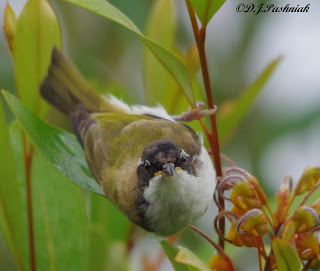Once again the tides are great for kayaking and seeing the shorebirds and the weather is terrible! We've had 50mm (2 inches) of rain in the last 36 hours. This is certainly not as much as some areas are getting but I won't take my camera out in it.
Last Thursday I dodged the showers and walked out to Mullens. It rained just before I got down there and then rained again just after I reached the car to drive home. In between I saw some interesting birds.
The bigger shorebirds were on the far side of the bay and inaccessible for photos. However, as I walked out onto the saltmarsh flats I saw some small birds and a few terns on my side of the bay.

Gull-billed Terns
(Sterna nilotica) nest inland where it is wet but spend the rest of the time out here on the coast. Birds in breeding plumage have a full dark cap and those in non-breeding plumage have only a black patch around the eye. Both of these birds in non-breeding plumage still show some dark pin-feathers on their heads.

There was a large flock of Lesser Sand-Plovers
(Charadrius mongolus) roosting with the Terns at the edge of the water.

Further around the bay were flocks of mixed Red-capped Plovers and Red-necked Stints. I photographed one Red-necked Stint
(Caladris ruficollis) standing with the Lesser Sand-Plovers. The Stint looked very small standing next to the Plovers.

I also photographed one Little Tern
(Sterna albifrons) standing with the Lesser Sand-Plovers. This is one of the migratory terns which come down here from Asia during our summer.
 For more bird photos visit the Bird Photography Weekly.
For more bird photos visit the Bird Photography Weekly.

 The next day they were back and several with the usual black caps sat up in the trees and preened while I came close and took their photos.
The next day they were back and several with the usual black caps sat up in the trees and preened while I came close and took their photos. 




















